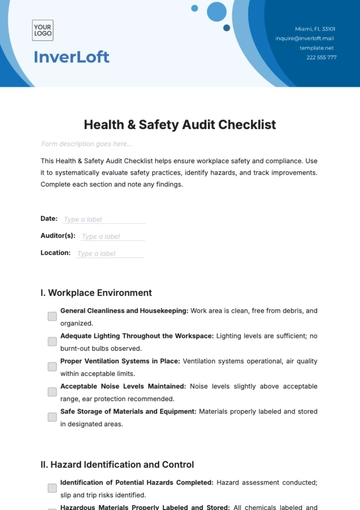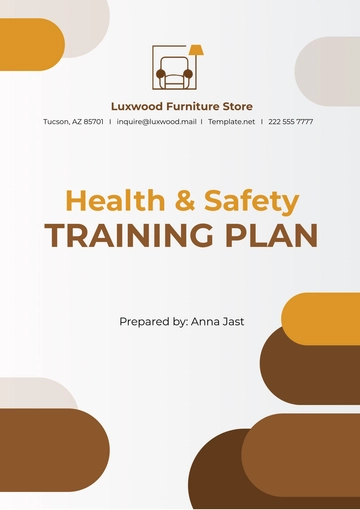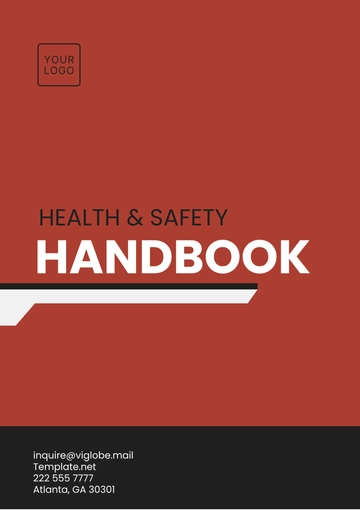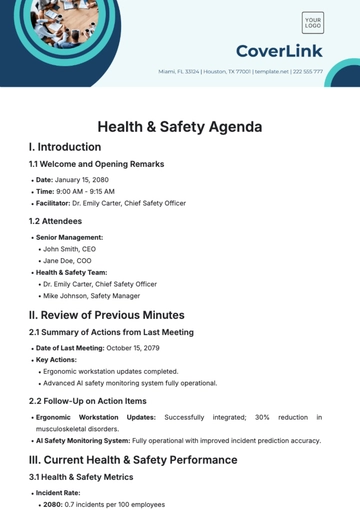Free Health & Safety Legal Compliance Impact Study

Impact Study
I. Executive Summary
This study offers an in-depth analysis of the effectiveness of health and safety legal compliance within [Your Company Name]. It evaluates how current practices align with legal standards and their impact on workplace safety and employee health.
Significance
Understanding the impact of legal compliance is crucial for ensuring a safe work environment and mitigating risks. This study highlights areas of success and identifies opportunities for improvement, guiding future safety initiatives.
II. Introduction to Health and Safety Compliance
Legal Framework
The study focuses on key legislation such as the Occupational Safety and Health Act (OSHA) and specific industry-related regulations. These laws provide the framework for workplace safety and employee health standards.
Purpose of the Study
The goal is to assess the effectiveness of [Your Company Name]'s compliance with these regulations, understand the impact on operational safety, and identify areas for enhancement in our safety protocols.
III. Methodology
This section describes the methodologies used in the study, including data collection and analysis techniques, providing a foundation for understanding the study's findings.
A. Data Collection
Data was collected through employee surveys, safety audit reports, and analysis of incident records. Interviews with key personnel in the safety department provided additional insights into the implementation of health and safety protocols.
B. Analysis Techniques
The data was analyzed using statistical methods to identify trends and correlations. Compliance levels were evaluated against industry benchmarks to gauge the effectiveness of current health and safety practices.
IV. Findings and Observations
Here, the study's key findings and observations are presented, offering a detailed look at the current state of health and safety compliance within the company.
A. Compliance Levels
The study revealed a high level of compliance with mandatory safety training and PPE usage. However, gaps were identified in emergency response planning and hazard communication.
Aspect | Impact of Compliance | Impact of Non-Compliance |
Employee Morale | Positive Impact | Employees felt safer and more valued in a compliant environment. High morale was linked to effective safety training and PPE availability. |
Workplace Accidents | Reduced Incidents | Compliance in training and PPE usage correlated with a decrease in workplace accidents and injuries. |
Emergency Preparedness | Increased Risk | Lack of regular emergency drills led to uncertainty in emergency response, potentially increasing risk during actual emergencies. |
Legal Repercussions | Potential Risks | The gaps in hazard communication could lead to non-compliance with OSHA regulations, posing legal and financial risks. |
V. Recommendations
Based on the study's findings, this section provides actionable recommendations for improving health and safety compliance, aiming to enhance workplace safety.
A. Improvement Strategies
Enhance emergency response training and conduct regular drills. Improve hazard communication through frequent safety meetings and updated signage.
Strategy | Objective | Implementation Steps |
Enhance Emergency Response Training | To ensure all employees are adequately prepared for emergencies. | Develop comprehensive emergency response training modules. Schedule regular training sessions and emergency drills for all staff. |
Conduct Regular Drills | To reinforce emergency response procedures and readiness. | Organize monthly or quarterly emergency drills. Include scenarios for different types of potential emergencies. |
Improve Hazard Communication | To ensure consistent and effective communication of workplace hazards. | Regular safety meetings to discuss and update on workplace hazards. Update and maintain clear signage in all work areas. |
Develop Reporting Protocols | To streamline the process of reporting hazards. | Establish clear and accessible channels for reporting hazards. Encourage employee participation and feedback in reporting systems. |
B. Best Practices
Adopt a continuous improvement approach to safety compliance. Implement a safety committee to oversee and review safety practices regularly.
Best Practice | Purpose | Implementation Guidelines |
Continuous Improvement Approach | To ensure ongoing advancement in safety standards. | Regularly assess and update safety protocols. Stay informed about new safety technologies and methodologies. |
Implement a Safety Committee | To oversee and maintain safety practices within the organization. | Form a committee comprising members from various departments. Assign responsibilities for monitoring, reviewing, and suggesting improvements in safety practices. |
Engage in Safety Training Workshops | To keep employees informed and skilled in safety practices. | Host workshops led by external safety experts. Encourage interactive and hands-on training sessions. |
Foster a Safety-First Culture | To prioritize safety in every aspect of work. | Promote safety as a core value in company communications and culture. Recognize and reward safe practices and improvements. |
Regular Safety Audits | To identify and rectify potential safety issues. | Schedule regular internal and external safety audits. Use audit findings to guide safety improvements and policy updates. |
VI. Conclusion
The study confirms the strong correlation between legal compliance and workplace safety. Continuous monitoring and proactive improvements are essential for maintaining high safety standards. Future studies should focus on long-term trends in safety compliance and explore the impact of technological advancements in safety management.
- 100% Customizable, free editor
- Access 1 Million+ Templates, photo’s & graphics
- Download or share as a template
- Click and replace photos, graphics, text, backgrounds
- Resize, crop, AI write & more
- Access advanced editor
Unlock peace of mind with Template.net's Health & Safety Legal Compliance Impact Study Template. This editable and customizable template, powered by our Ai Editor Tool, streamlines the process of assessing and ensuring legal compliance. Effortlessly navigate health and safety regulations, safeguarding your business with confidence. Get started with Template.net today.





























